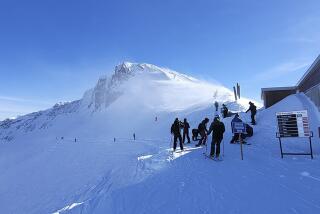Tourists Flowing to Volcano
- Share via
CASTLE ROCK, Wash. — Visitors who trek up the west side of Mt. St. Helens this summer may get to see a plume of volcanic ash rising from the crater, depending on the mountain’s mood.
But it’s a near certainty that they will see lots of other people.
Mt. St. Helens rumbled back to life last fall -- the volcano let loose its first plume of ash and debris since 1986, spewing numerous times since -- and visitation increased 33% for the first six months this year. And the summer tourist season didn’t really get started until July, said Tom Knappenberger, a spokesman for the U.S. Forest Service.
About 250,000 people come each year to see the volcano that erupted with devastating force in May 1980, killing 57 people and sawing 1,314 feet off the top of the mountain. The 25th anniversary could account for some of the increased tourist traffic, Knappenberger said.
Scientists from the U.S. Geological Survey and the University of Washington monitor the mountain 24 hours a day and offer daily reports on a website. In recent weeks, there have been small earthquakes, as well as minor steam and ash emissions. Mt. St. Helens is building a new lava dome.
The website warns: “The eruption could intensify suddenly or with little warning and produce explosions that cause hazardous conditions within several miles of the crater.”
Eric Mitchell-Healey, a 15-year-old from Swarthmore, Pa., was lucky enough to see a plume during a recent family vacation to the Cascade Mountains.
“It was incredible to see it rising out of the mountain like that,” he said.
Kit Healey, the boy’s mother, said that seeing the emission made them want to learn more about the mountain.
“They do a fantastic job here,” she said of the Forest Service. “The visitors centers, the presentations -- they really try to give you a sense of what it was like for those people on the mountain that day in 1980.”
Park rangers also try to pass along some science.
At Johnston Ridge, elevation 4,255 feet, ranger Jason Harrison stood in the 80-degree sunshine recently to speak to about 50 visitors who crowded around charts of seismic activity and pictures of previous ash emissions.
“We had a big ash plume at 9:30 this morning,” Harrison told the crowd. “And I guarantee we’ll have another one. I just don’t know when.”
He said the increased interest in Mt. St. Helens was phenomenal.
Kristine Cochrane-Bell, visitor center director for the Forest Service facilities at Johnston Ridge and Coldwater Ridge, has seen more volunteers at the Mt. St. Helens National Volcanic Monument.
“We had 75 applications for volunteer interpreters this year,” she said. Of those, 25 people went through the training program and 20 are now working. In the summer of 2004, there were 10 volunteers.
Cochrane-Bell said public education was the most important thing her staff could provide.
“Just because you don’t see steam and ash every day doesn’t mean the mountain isn’t erupting,” she said. In an emergency, the visitor centers could be evacuated in a timely manner, she said.
The recent geological activity on Mt. St. Helens also has had an effect -- good and bad -- on local businesses.
Most visitors to the west side of Mt. St. Helens arrive via state Highway 504, which runs 52 miles from Interstate 5 to Johnston Ridge, named for David Johnston, a geologist who died in the 1980 eruption.
The private concessionaire at the Hoffstadt Bluff Visitor Center had its best June ever, even though “the weather wasn’t all that great,” said Mark Plotkin, director of Cowlitz County’s tourism department.
But at the Lone Fir Resort, a motel and RV campground near the southwest slope, owner Larry Semm said business had been down.
“It’s a boom for people up north, where they built the visitors centers,” he said. “But for us, here on the south side, our big draw was the lure of climbing an active volcano.”
The mountain has been closed to climbing since last fall.
Now, Semm said, the only visitors he sees on weekdays are people who get lost.
Linda Kirkish of Vashon Island Air, a tour company about 100 miles north of here, said the possibility of seeing an ash plume had changed the way visitors regarded Mt. St. Helens.
One client, Kirkish said, made the trip from California with her family just to see the mountain from the air.
Previously, she said, people planning a trip to the Pacific Northwest flew by the mountain as an add-on activity. But not this customer.
“For her,” Kirkish said, “it was all about the mountain.”
More to Read
Sign up for The Wild
We’ll help you find the best places to hike, bike and run, as well as the perfect silent spots for meditation and yoga.
You may occasionally receive promotional content from the Los Angeles Times.






